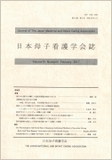Japanese
English
- 有料閲覧
- Abstract 文献概要
- 参考文献 Reference
- サイト内被引用 Cited by
目的
本研究の目的は、成熟期にある女性の体温の特徴、ならびに冷え症の自覚の有無によって身体的所見や日常生活行動、冷えの随伴症状があるのか否かを明らかにする。さらに、冷え症の予防・対策のために成熟期女性が実践している行動とその特徴を検討する。
対象と方法
対象は26歳から45歳の既婚女性241名である。前額部と足底部の深部温及び表面温の測定と、体組成計による測定を行った。また、冷え症の自覚と日常生活行動、冷えの随伴症状等の質問紙調査と、冷え症の予防・対策で意識的に実践している行動を具体的に話してもらった。分析にはχ2検定と対応のないt検定、一元配置分析を使用し、有意水準は5%とした。話してもらった内容は質的に分析し類型化した後、量的データとして置き換え、分析を行った。
結果
対象者の平均年齢は36.5歳で、冷え症の人は170名(70.5%)であった。足底部の平均深部温は30.6℃、前額部との深部温較差は平均6.2℃で、6℃以上差があった者は123名(51.0%)であった。冷え自覚群は足底部の深部温・表面温が有意に低く、前額部と足底部の温度較差も有意に開いていた。また、体重、BMI、体脂肪率、基礎代謝量が有意に少なかった。冷えの随伴症状では、便秘、浅眠、倦怠感、易疲労感に加えて、抑うつ気分や意欲の低下に有意差が認められた。予防対策で対象者が意識的に行っていたのは「靴下の着用」、「厚着・重ね着」、「カイロの使用」の順に多かったが、体温に差が見られたのは「厚着・重ね着」と「運動の実施」の2項目であった。
結論
成熟期女性は冷え症を自覚する割合が多く、体温較差から"冷え"が重症化していたと考える。この時期の既婚女性は家事や仕事、育児等で多忙であり、自らの健康への関心が薄れる時期でもある。冷え症が持続することは倦怠感や抑うつ気分を悪化させることに繋がり、健康感の喪失やQOLの低下にも影響を及ぼす。冷え症の予防・対策に向けて積極的な教育の必要性が示唆された。
Purpose
(1)To identify distinguishing physical findings, daily-life activities, and the presence of concomitant symptoms of hiesho in women aged 26-45 years, based on their body temperature, (2)to assess self-awareness of hiesho, and (3)to identify activities that mature stage women consciously perform to prevent and counteract sensitivity to the cold.
Subjects and Methods
The subjects were 241 women aged 26-45 years. Core and surface temperatures of the forehead and soles were measured, while considering body composition for each subject. Subjects also completed a questionnaire to assess self-awareness of hiesho, their daily-life activities, and their observation of any concomitant symptoms of hiesho. They provided details about activities performed to prevent and counteract sensitivity to the cold. The analysis used the chi-square test, unpaired t-test, and one-way analysis of variance(ANOVA) with a significance level of 5%. After qualitatively analyzing and classifying the details of the subject discussions, these details were entered as quantitative data and were analyzed.
Results
The average age of subjects was 36.5 years, and 170 subjects(70.5%) had hiesho. The average core temperature of the foot soles was 30.6℃, and the average difference between this temperature with the core forehead temperature was 6.2℃. 123 subjects(51.0%) had a difference ≧6℃. For the group that was self-aware of the cold, the core and surface temperatures of their foot soles were significantly lower, and there was a significant difference between the temperature of the forehead and that of their foot soles. Further, their body weight, BMI, body fat percentage, and basal metabolic rate were significantly low. Concomitant symptoms of feeling cold, such as constipation, light sleep, a sense of physical weariness and fatigability were observed, and subjects also reported feelings of depression and lowered motivation. In descending order, the most common activities that subjects consciously performed as preventative measures were wearing socks, wearing thick or multiple layers of clothing, or using a heating pad. Differences in body temperature were observed in the group that exercised while wearing thick or multiple layers of clothing.
Conclusion
A large share of mature stage women are self-aware of hiesho, and with the difference in body temperatures widening, cold became more severe. Married women aged 26-45 years are busy with tasks such as housework, employment, and raising children. This is also a time when interest in their own health wanes. Continued hiesho leads to worsening physical weariness and an increase in depression. It also deteriorates health and lowers the quality of life. This suggests the necessity for active education in methods of counteracting and preventing sensitivity to the cold.
Copyright © 2017, The Japan Maternal and Infant Caring Association All rights reserved.


